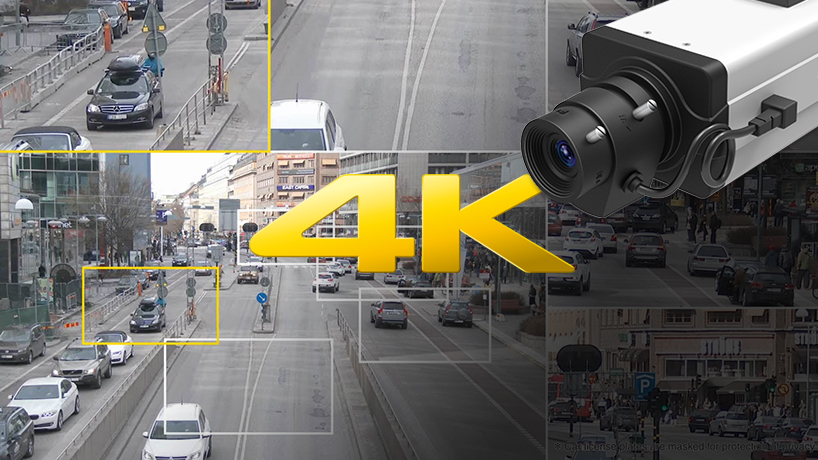
Hisilicon 4K UHD H.265 IP Camera Solution Hi3519 + IMX274
It has been almost a year since Hisilicon officially launched the Hi3519 SoC dedicating to 4K UHD IP cameras. No more stories, no rumors, here we introduce you the 4K UHD IP Camera that based on Hi3519 + IMX274 hardware design. Furthermore, we would like to share you both day and night video footage that captured by this 4K UHD IP camera. Hi3519 is a powerful processor has the 4K UHD video encoding capability, it also supports the latest H.265/HEVC video compression. Sony IMX274 is a high performance, low illumination Exmor R CMOS image sensor providing 8.51-megapixel, through leveraging the IMX274, this camera can shoot 3840*2160 resolution video (4K UHD, or 2160P) with 30 frames per second.
Hi3519 + IMX274 4K Ultra HD Network Camera Video (Day)
Hi3519 + IMX274 4K Ultra HD Network Camera Video (Night)
- Image sensor: Sony Exmor R CMOS Image Sensor IMX274
- Sensor resolution: 8.51 megapixel
- Max. video resolution: 3840x2160 (4K Ultra HD, 2160P)
- Minimum illumination: 0.01Lux/0Lux (IR on)
- Day & Night: Mechanism IR-CUT filter
- Main processor: Hisilicon Hi3519
- Video compression: HEVC/H.265
- Video profile: 3840*2160/2592*1520/2048*1520/1920*1080/1280*720
- Frame rate: Up to 30 fps @ 3840*2160
- Image setting: brightness, contrast, Hue, saturation, sharpness, AGC, shutter time, mirror, flip
- Image function: WDR, Day&Night adjustment, 2D/3D denoise, BLC, defog, AWB, Privacy mask, motion detection
- Video bitrate: CBR, VBR
- Operation temperature: -10℃∼+50℃
Benefits of using 4K Ultra HD cameras
4K Ultra HD resolution is four times higher than Full HD 1080p resolution, users can now benefit from four times detail with minimal increase in costs. 4K UHD provides users with better forensic zoom and delivers minute detail than one could with higher megapixel cameras. In high-quality images clicked through megapixel technology, many users still find the image “choppy” or pixelated when using the digital zoom feature. But with 4K, one can push the zoom to greater detail because of its finer pixel geometry.
Benefits of using H.265 IP cameras
With the rapid development of IP video surveillance technology, the current H.264 (MPEG-4/AVC) standard no longer meets the requirement of video encoding for higher image resolution. Especially, 4K UHD and 8K UHD video equipment will inevitably become the trend in the future. As the next generation video compression standard, H.265 comes into market, H.265 or High Efficiency Video Coding (HEVC) has been gradually adopted in high definition IP surveillance products such as HD IP cameras, NVRs. Under the same image quality condition, utilizing H.265 video compression, IP cameras can save 50% bandwidth and video storage.
Advantages of IP cameras
Comparing the HD CCTV cameras (such as AHD/CVI/TVI), IP cameras are the future proof products, they can provide higher image resolution, more functionalities and remote surveillance easier. There are many other advantages including:
- Improved Efficiency. Nonstop monitoring of activity is quickly becoming unnecessary. IP cameras have activity alert systems that can notify staff when problems occur, feeding live video to a computer device such as a laptop, desktop computer, tablet, or smartphone. This functionality is particularly helpful for non-security uses such as delivery arrival, customer service, and work-flow observation. These cameras have sophisticated on-board processors that can interpret events in real time. Alerts will be sent for serious matters, not minor movements that are captured.
- System Integration. IP cameras can easily pair with alarm systems. Some models allow for integration with lighting, environmental controls, and access systems to create a comprehensive virtual presence.
- Backwards Compatibility. For organizations with existing analog closed circuit cameras, video servers technology lets you leverage existing systems. Existing legacy analog cameras can be used in locations that would call for IP cameras. Recording systems allow for the storage of data coming from both IP and analog video cameras.
- Less Cabling. With analog cameras, there is a need for up to three cable systems — power, audio and video — connected to each camera. With IP cameras, especially PoE models, one cable can suffice. In many locations, network cables are already installed, saving even more.
- Lower System Cost. By leveraging your existing computer network hardware and cabling, installing IP cameras provide a distinct savings over new analog camera systems.
- Security And Privacy. Advanced security features in IP cameras encrypt video from end to end, greatly reducing unauthorized access.
- High Resolution. As digital devices, IP cameras maximize use of camera imagers to produce images with up to 25 percent more resolution. There are even megapixel cameras with even more detailed resolution options that provide up to 30 frames per second of real-time video. This improved resolution also improved recording functionality too. Analog often generate blurred images when recording video of objects moving at fast speeds. IP video allows crisp and clear resolution of every frame.
- System Proof. Having access to surveillance footage without needing a dedicated observation system or DVR
Get My Latest Posts
Subscribe to get the latest updates.
Your email address will never be shared with any 3rd parties.
Scan me




